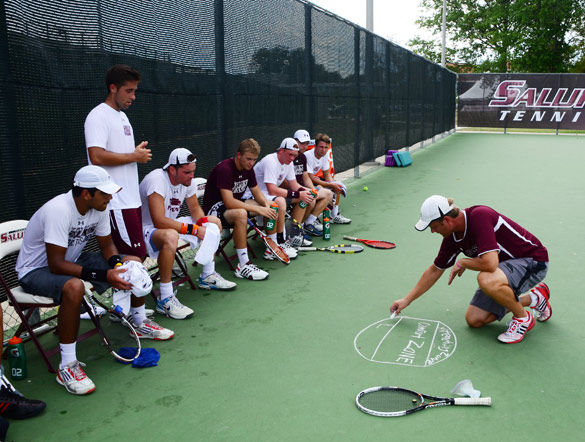Letter to the editor: Cut football, not tennis

Then-SIU men’s tennis coach Dann Nelson draws a diagram for his players Sept. 17, 2013 during practice at University Courts. (Daily Egyptian file photo)
February 2, 2017
It’s Southern Illinois University Carbondale sports quiz time.
Question: What do the following sports Division I universities have in common: American, Boston, Bradley, California State (Long Beach, Fullerton and Northridge), California (Santa Barbara and Riverside), DePaul, Marquette, St. Louis and Wisconsin (Milwaukee)?
Answer: They are among the more than 60 quality institutions of higher education deciding in past decades that enhancing academics and less-expensive sports programs made both academic and financial sense. As a result, these schools axed their expensive, revenue-losing football programs. More than 180 non-Division I colleges and universities also have made the same call.
Advertisement
As an example, Wichita State University, a Division 1 institution in the Missouri Valley Conference, axed its football program in 1986 — a program begun in 1897. In the 31 years since making that decision, its women’s tennis team has regularly been one of the best in the MVC.
And Wichita’s men’s baseball team received additional resources, allowing it in the past 31 years to garner:
- Six College World Series appearances
- 22 NCAA Tournament appearances
- 19 regular-season MVC championships
- 14 MVC tournament championships
Wichita State saved $4.1 million in 1986 by eliminating football. Multiply that number, and factor in annual increases over some 30 years, and it’s clear Wichita State has saved — and reinvested in its academics and other sports programs — considerably more than $130 million.
And by the way, Wichita State has also increased its enrollment until it now trails SIU only by some 1,500 students.
But although faced with declining revenue, a draconian state budget, an education-unfriendly governor and top administrators with lackluster records of increasing enrollments, SIU has disregarded decisions made by Wichita State and other universities. Rather than axing its own most money-losing (football) sports team, SIU decided instead to eliminate men’s and women’s tennis — teams with overall winning records in recent years.
By shuttering SIU’s tennis program (and also some swimming scholarships) the university estimates to save $660,000 – a pittance when compared to what could be saved were football to be axed.
In the just-completed Australian Tennis Open Tournament, two of the men’s and women’s finalists were African Americans, one Swiss and one from Spain. SIU’s tennis teams have been infused with similar diversity, with members from Denver to Britain to Moscow, thus making this university a destination point for national and international tennis scholarship athletes.
Advertisement*
And tennis, a life-long sport, attracts true student athletes, something important to any Level I Research Institution. According to an athletics news release quoted in a recent Daily Egyptian article, each SIU tennis team was recognized by the Intercollegiate Tennis Association “as an All-Academic Team in eight of the last 10 years by earning a cumulative team GPA of 3.2 or higher.”
So before pulling the plug on its tennis teams, SIU administrators should carefully examine decisions by other universities and ask themselves whether it really makes good academic and fiscal sense to eliminate its tennis teams.
William Babcock, senior media ethics professor in SIU’s School of Journalism, is a former varsity football and tennis player, and an SIU graduate.
Advertisement







